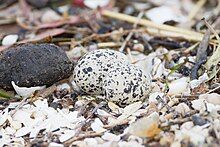| Red-capped plover | |
|---|---|

| |
| Male in breeding plumage | |

| |
| Female in breeding plumage | |
| Conservation status | |
 Least Concern (IUCN 3.1) | |
| Scientific classification | |
| Domain: | Eukaryota |
| Kingdom: | Animalia |
| Phylum: | Chordata |
| Class: | Aves |
| Order: | Charadriiformes |
| Family: | Charadriidae |
| Genus: | Anarhynchus |
| Species: | A. ruficapillus |
| Binomial name | |
| Anarhynchus ruficapillus (Temminck, 1821) | |
The red-capped plover (Anarhynchus ruficapillus), also known as the red-capped dotterel, is a small species of plover.
It breeds in Australia. This species is closely related to (and sometimes considered conspecific with) the Kentish plover, Javan plover, and white-fronted plover.
Description
Red-capped plovers have a white forehead and underparts. Their upperparts are mainly grey-brown. Adult males have a rufous or reddish-brown crown and hindneck. Adult females have a paler rufous and grey-brown crown and hindneck, with a pale loreal stripe. The upperwing of Charadrius ruficapillus shows dark brown remiges (flight feathers) and primary covert feathers with a white wingbar in flight. Its length is 14–16 cm (5.5–6.3 in) and its wingspan is 27–34 cm (10.6–13.4 in); it weighs 35–40 g (1.2–1.4 oz).
Breeding plumage shows a red-brown crown and nape with black margins. Non-breeding plumage is duller and lacks the black margins.
Distribution and habitat
The red-capped plover is widespread in Australia; it is a vagrant to New Zealand, although it bred there for some time in small numbers from 1950–1980. The species occupies a range of coastal and inland habitats, including estuaries, bays, beaches, sandflats, and mudflats; inland saline wetlands. It is also found in inland wetland areas with bare ground.
Food

The red-capped plover feeds mostly on small invertebrates, especially molluscs, crustaceans, and worms.
Breeding


The red-capped plover is a seasonal breeder on the coasts of Australia, but breeds in response to unpredictable rains inland. The plover nests on the ground close to wetlands; the nest is a small depression in the ground, with minimal or no lining. The clutch of two pale yellowish-brown eggs are speckled with black spots. The Incubation period is 30 days; incubating is mainly done by the female. Upon hatching, the young are open-eyed, mobile, and relatively mature (precocial); they flee the nest shortly after birth (nidifugous).
Conservation
With a large range and no evidence of significant population decline, this species' conservation status is of Least Concern.
References
- BirdLife International (2016). "Charadrius ruficapillus". IUCN Red List of Threatened Species. 2016: e.T22693832A93425838. doi:10.2305/IUCN.UK.2016-3.RLTS.T22693832A93425838.en. Retrieved 12 November 2021.
- Grosset, Arthur. "Red-capped Plover Charadrius ruficapillus". Retrieved 9 January 2011.
- ^ Piersma, Theunis; Weirsma, Popko (1996), "Family Charadriidae (Plovers)", in del Hoyo, Josep; Elliott, Andrew; Sargatal, Jordi (eds.), Handbook of the Birds of the World. Volume 3, Hoatzin to Auks, Barcelona: Lynx Edicions, pp. 432–433, ISBN 84-87334-20-2
- BirdLife International. (2006). Species factsheet: Charadrius ruficapillus. Downloaded from http://www.birdlife.org on 12 February 2007
- Marchant, S.; Higgins, P.J.; & Davies, J.N. (eds). (1994). Handbook of Australian, New Zealand and Antarctic Birds. Volume 2: Raptors to Lapwings. Oxford University Press: Melbourne. ISBN 0-19-553069-1
External links
 Media related to Charadrius ruficapillus at Wikimedia Commons
Media related to Charadrius ruficapillus at Wikimedia Commons Data related to Charadrius ruficapillus at Wikispecies
Data related to Charadrius ruficapillus at Wikispecies